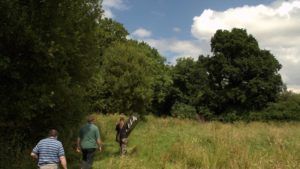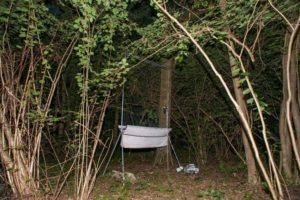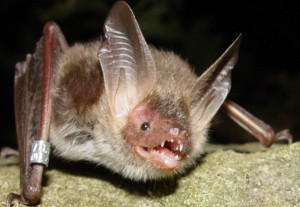Bechstein’s is one of the rarest British bats. Their preferred woodland homes are being destroyed or intensively managed and the challenges of studying an elusive night flying animal means much remains to be learned about this wonderful species.
In this guest blog, Patrick Wright, PhD researcher at Exeter University, gives us a glimpse into what it is like researching an animal that leads such a different life to us.
Changing landscapes
The sun rise is blinding me as I’m driving down the M5 one hot August morning. I am heading to a woodland on the outskirts of Trowbridge (Wiltshire) to meet up with Keith Cohen and Lis Weidt. A number of volunteers have also, like me, travelled long distances to reach this site with the hope to see one of Britain’s most elusive and least known mammals, the Bechstein’s bat.
Broadleaved woodlands dramatically declined in Britain and reached an all-time low during the 20th century. Such important declines were thought to have strong consequences on woodland specialists, such as the Bechstein’s bat. While people today live in a well-connected world where they may easily travel across the country for a close encounter with this unique species, the Bechstein’s bat is likely to struggle in maintaining contact with other bat populations. This has lead me to one of the fundamental questions of my PhD. By using molecular markers, I want to find out how closely related the populations across Britain are and whether any are showing any signs of isolation and inbreeding. I then will use this genetic information to quantify the effect that the surrounding landscape, such as road or urban areas, are having on the genetic connectivity between populations.

Daytime research
At 9:00 am, we split up into two groups and start doing the box checks. The first box was empty and so was the second and the third… It is 11:30 am, half of the boxes have been checked and no bats have yet been found. It is my turn to check the next one. I climb the ladder and immediately get a whiff of a pungent characteristic smell of a box full of bats. I carefully open it and inside I see a cluster of bats with long ears. We have some Bechstein’s! People remain quiet but we all share a reserved excitement to not disturb the bats.
Keith carefully takes out the bats and places them in cloth bags and then gently takes one out and shows it to the newcomers. For many people, this is their only chance to see this species up close and help with the long-term monitoring that Lis and Keith are undertaking in this woodland. The long ears and fox like face of Bechstein’s bats makes them easy to differentiate from other closely related species. We now have to be quick and process all the bats to avoid disturbing them too much. Everyone chips in taking notes, weighing and measuring all the bats whilst Keith places a unique ring on the new bats as part of the monitoring study. We then replace the box back up the tree with all the bats cuddled up inside before continuing with our checks. It’s not before 4 pm that all the boxes have been checked and that everyone starts going their own way. I have collected a good number of samples for my study, but field work is not over as I have to head straight to Buckinghamshire to study a population at the edge of the species range.

On the hunt for a roost
I head out the next afternoon with Chris Damant, a local ecologist, to decide where we’ll be trapping for the next few nights. Chris has been studying the local wildlife of Bernwood forest (Buckinghamshire) for years and very few people can claim they know their neck of the woods the way he does. He points out a large oak tree in a hedgerow and tells me that he has previously radio tracked Bechstein’s back to this tree. He then shows a small copse across the neighbouring field and says that some have also been found in there. We decide to look for the roost and I rapidly spot a woodpecker hole, a favourite for Bechstein’s. I point it out to Chris, but before he’s able to confirm that this was indeed the roost, a loud yaffling sound resonates in the wood. A green woodpecker flies into the hole, before resurging out in a hurry. We won’t be trapping here tonight!
Night time trapping
We decide to trap in a nearby woodland where Henry Schofield, my PhD supervisor from the Vincent Wildlife Trust and expert in bat research and conservation, will be joining us. The sun has set and it’s time to set up the harp traps that will be used to catch the bats. It only takes thirty minutes to catch our first bat which is a Natterer’s bat, a common species in these woods and a close cousin of the Bechstein’s. We catch a few more bats, including a Daubenton’s bat, but it isn’t before 11 pm that the first Bechstein’s is caught. It is very hard to estimate the age of bats as juveniles grow very fast and have usually fully grown within a few weeks. However, I can tell that this one is a two months old female as the head torch helps me visualise the finger joints that aren’t yet fully ossified. As I release this bat, Henry arrives with another female Bechstein’s. This will be our second and last one of the night. The sky is clear and the air is getting colder. We have caught nine bats of three different species so far but none have been caught for the last 45 minutes. We start making plans and decide to call it a night at 1:30 am. We need some rest as we’ll be trapping for three more nights.

